The Impact of the Internalization of External Costs in the Competitiveness of Short Sea Shipping
Abstract
:1. Introduction
- (i)
- By 2030, rail and waterborne-based intermodal transport will be able to compete on equal footing with road-only transport in the EU40, in terms of the share of external costs internalized.
- (ii)
- All external costs of transport within the EU will be covered by the transport users at the latest by 2050.
2. External Costs: Types and Degree of Internalization
2.1. The Concept and Types of External Costs
2.2. Degree of External Costs Internalization
3. Methodology
4. Numerical Application
4.1. Case Study Definition
4.2. Numerical Results for an Origin/Destination Pair
4.3. Numerical Results for Multiple Origin/Destination Pairs
5. Conclusions
Supplementary Materials
Author Contributions
Funding
Institutional Review Board Statement
Informed Consent Statement
Data Availability Statement
Acknowledgments
Conflicts of Interest
References
- European Commission. Roadmap to a Single European Transport Area—Towards a Competitive and Resource Efficient Transport System; European Commission: Brussels, Belgium, 2011. [Google Scholar]
- European Commission; Secretariat-General. The European Green Deal; European Commission: Brussels, Belgium, 2019. [Google Scholar]
- European Commission; Directorate-General for Mobility and Transport. Sustainable and Smart Mobility Strategy—Putting European Transport on Track for the Future; COM/2020/789 Final; European Commission: Brussels, Belgium, 2020. [Google Scholar]
- Community of European Railway and Infrastructure Companies. Position Paper, Implementing User-Pays and Polluter-Pays in Road Charging: CER’s Proposals for Council Discussions on Eurovignette; CER: Brussels, Belgium, 2019. [Google Scholar]
- Electro-Mobility Platform. Position on the Proposal of 31 May 2017 by the European Commission for a Revised ‘Eurovignette’ Directive (1999/62/EC) on Road Charging. Available online: https://www.platformelectromobility.eu/wp-content/uploads/2018/02/E-Mobility-Platform-Eurovignette-paper-for-Council-18-March-2019.pdf (accessed on 18 March 2019).
- Community of European Railway and Infrastructure Companies. Position Paper, Europe’s Economic Recovery after Covid-19: Help Finance It by Applying User-Pays and Polluter-Pays Principles in Transport; European Commission: Brussels, Belgium, 2020. [Google Scholar]
- van Essen, H.; van Wijngaarden, L.; Schroten, A.; Sutter, D.; Bieler, C.; Maffii, S.; Brambilla, M.; Fiorello, D.; Fermi, F.; Parolin, R.; et al. Handbook on the External Costs of Transport Version 2019—1.1; CE Delft: Delft, The Netherlands, 2019. [Google Scholar]
- Sambracos, E.; Maniati, M. Competitiveness between short sea shipping and road freight transport in mainland port connections; the case of two Greek ports. Marit. Policy Manag. 2012, 39, 321–337. [Google Scholar] [CrossRef]
- Tzannatos, E.; Papadimitriou, S.; Katsouli, A. The cost of modal shift: A short sea shipping service compared to its road alternative in Greece. Eur. Transp. Trasp. Eur. 2014, (56), Paper Nº2. 1–20. [Google Scholar]
- Hofbauer, F.; Putz, L.-M. External Costs in Inland Waterway Transport: An Analysis of External Cost Categories and Calculation Methods. Sustainability 2020, 12, 5874. [Google Scholar] [CrossRef]
- Raza, Z.; Svanberg, M.; Wiegmans, B. Modal shift from road haulage to short sea shipping: A systematic literature review and research directions. Transp. Rev. 2020, 40, 382–406. [Google Scholar] [CrossRef] [Green Version]
- van Essen, H.; van Wijngaarden, L.; Schroten, A.; Sutter, D.; Schmidt, M.; Brambilla, M.; Maffii, S.; El Beyrouty, K.; Morgan-Price, S.; Andrew, E. State of Play of Internalisation in the European Transport Sector; CE Delft: Delft, The Netherlands, 2019. [Google Scholar]
- Ramalho, M.; Santos, T.; Soares, C.G. External costs in short sea shipping based intermodal transport chains. In Developments in Maritime Technology and Engineering; Santos, T.A., Guedes Soares, C., Eds.; Routledge, Taylor & Francis Group: London, UK, 2020; pp. 63–72. [Google Scholar]
- Santos, T.A.; Ramalho, M.M.; Guedes Soares, C. Sustainability in short sea shipping-based intermodal transport chains. In Short Sea Shipping in the Age of Sustainable Development and Information Technology; Santos, T.A., Guedes Soares, C., Eds.; Routledge: London, UK, 2020; pp. 89–115. [Google Scholar]
- Ramalho, M.M.; Santos, T.A. Numerical modelling of air pollutants and greenhouse gases emissions in intermodal transport chains. J. Mar. Sci. Eng. 2021, 9, 679. [Google Scholar] [CrossRef]
- Vierth, I.; Sowa, V.; Cullinane, K. Evaluating the external costs of trailer transport: A comparison of sea and road. Marit. Econ. Logist. 2019, 21, 61–78. [Google Scholar] [CrossRef]
- Ricardo-AEA, TRT, DIW Econ & CAU. Update of the Handbook on External Costs of Transport; Ricardo-AEA: London, UK, 2014. [Google Scholar]
- Pigou, A.C. The Economics of Welfare; Palgrave classics in economics; Palgrave Macmillan: London, UK, 1920. [Google Scholar]
- World Bank. State and Trends of Carbon Pricing 2020; World Bank: Washington, DC, USA, 2020. [Google Scholar]
- Chatziioannou, I.; Alvarez-Icaza, L.; Bakogiannis, E.; Kyriakidis, C.; Chias-Becerril, L. A Structural Analysis for the Categorization of the Negative Externalities of Transport and the Hierarchical Organization of Sustainable Mobility’s Strategies. Sustainability 2020, 12, 6011. [Google Scholar] [CrossRef]
- Progiou, A.G.; Bakeas, E.; Evangelidou, E.; Kontogiorgi, C.; Lagkadinou, E.; Sebos, I. Air pollutant emissions from Piraeus port: External costs and air quality levels. Transp. Res. Part D 2021, 91, 102586. [Google Scholar] [CrossRef]
- Hintjens, J.; van Hassel, E.; Vanelslander, T.; Van de Voorde, E. Port Cooperation and Bundling: A Way to Reduce the External Costs of Hinterland Transport. Sustainability 2020, 12, 9983. [Google Scholar] [CrossRef]
- Janic, M. Modelling the full costs of an intermodal and road freight transport network. Transp. Res. Part D Transp. Environ. 2007, 12, 33–44. [Google Scholar] [CrossRef]
- Comi, A.; Polimeni, A. Assessing the Potential of Short Sea Shipping and the Benefits in Terms of External Costs: Application to the Mediterranean Basin. Sustainability 2020, 12, 5383. [Google Scholar] [CrossRef]
- Ambrosino, D.; Ferrari, C.; Sciomachen, A.; Tei, A. Intermodal nodes and external costs: Re-thinking the current network organization. Res. Transp. Bus. Manag. 2016, 19, 106–117. [Google Scholar] [CrossRef] [Green Version]
- Ambrosino, D.; Sciomachen, A.; Surace, C. Evaluation of flow dependent external costs in freight logistics networks. Networks 2019, 74(2), 111–123. [Google Scholar] [CrossRef]
- European Parliament; Council of the European Union. Directive 2011/76/EU of 27 September 2011 amending Directive 1999/62/EC on the charging of heavy goods vehicles for the use of certain infrastructures. Off. J. Eur. Union 2011, L269, 1–16. [Google Scholar]
- Schroten, A.; van Essen, H.; van Wijngaarden, L.; Sutter, D.; Andrew, E. Sustainable Transport Infrastructure Charging and Internalisation of Transport Externalities; Report for Directorate-General for Mobility and Transport; European Commission: Brussels, Belgium, 2019. [Google Scholar]
- Vierth, I.; Merkel, A. Internalization of external and infrastructure costs related to maritime transport in Sweden. Res. Transp. Bus. Manag. 2020, 100580. [Google Scholar] [CrossRef]
- Schroten, L.; van Wijngaarden, M.; Brambilla, M.; Gatto, S.; Maffii, F.; Trosky, H.; Kramer, R.; Monden, D.; Bertschmann, M.; Killer, V.; et al. Overview of Transport Infrastructure Expenditures and Costs; Report for Directorate-General for Mobility and Transport; European Commission: Brussels, Belgium, 2019. [Google Scholar]

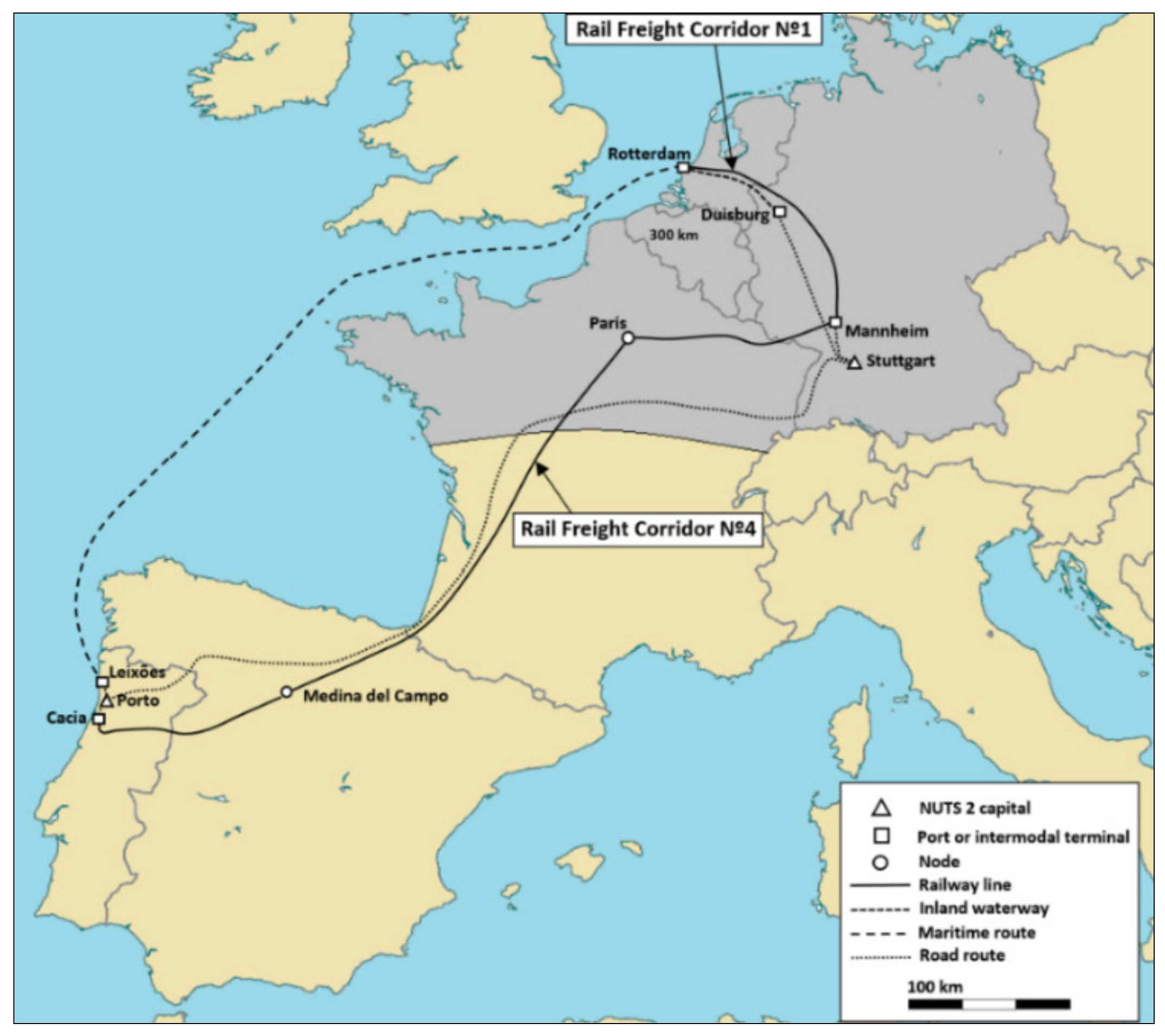
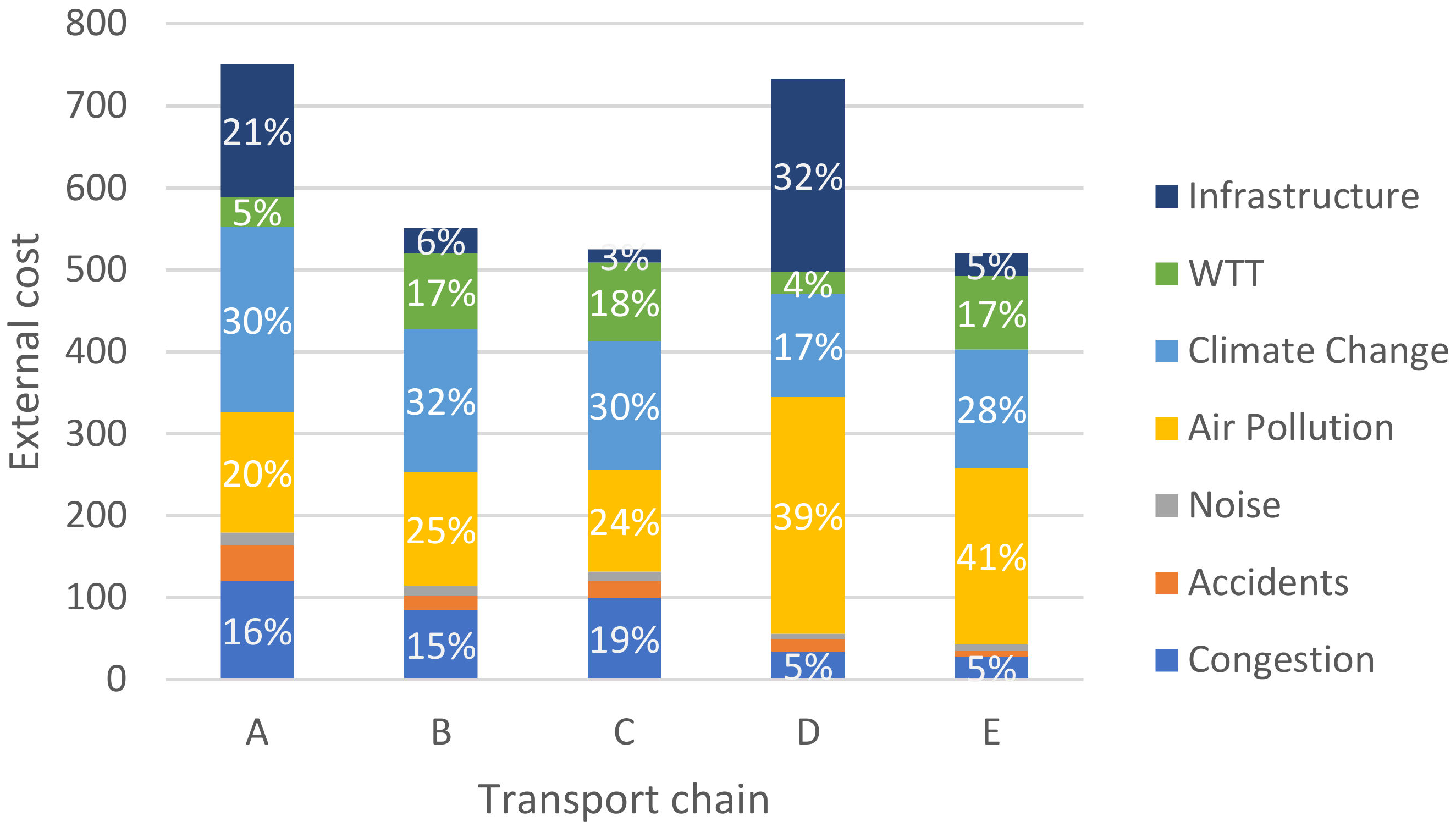


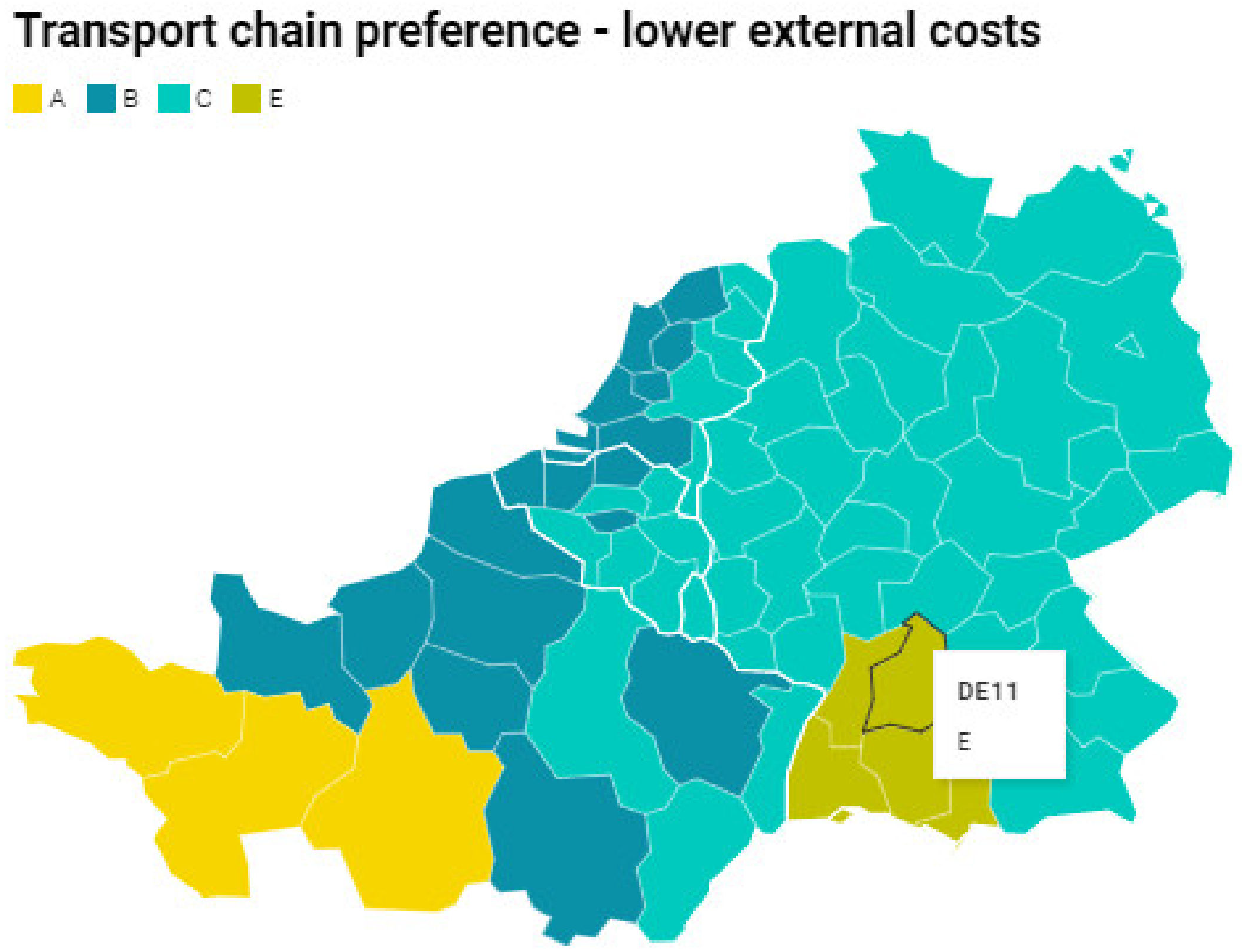
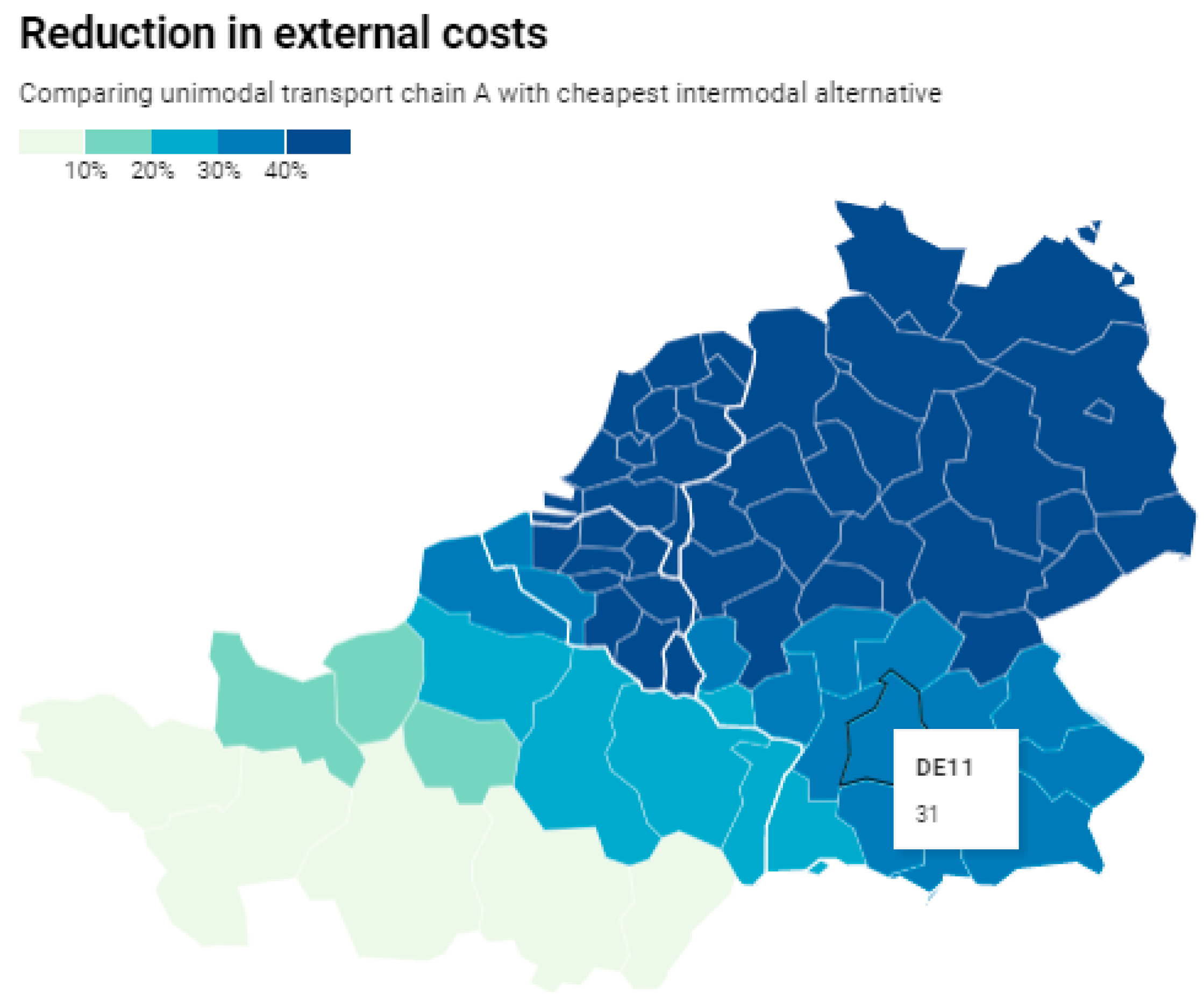
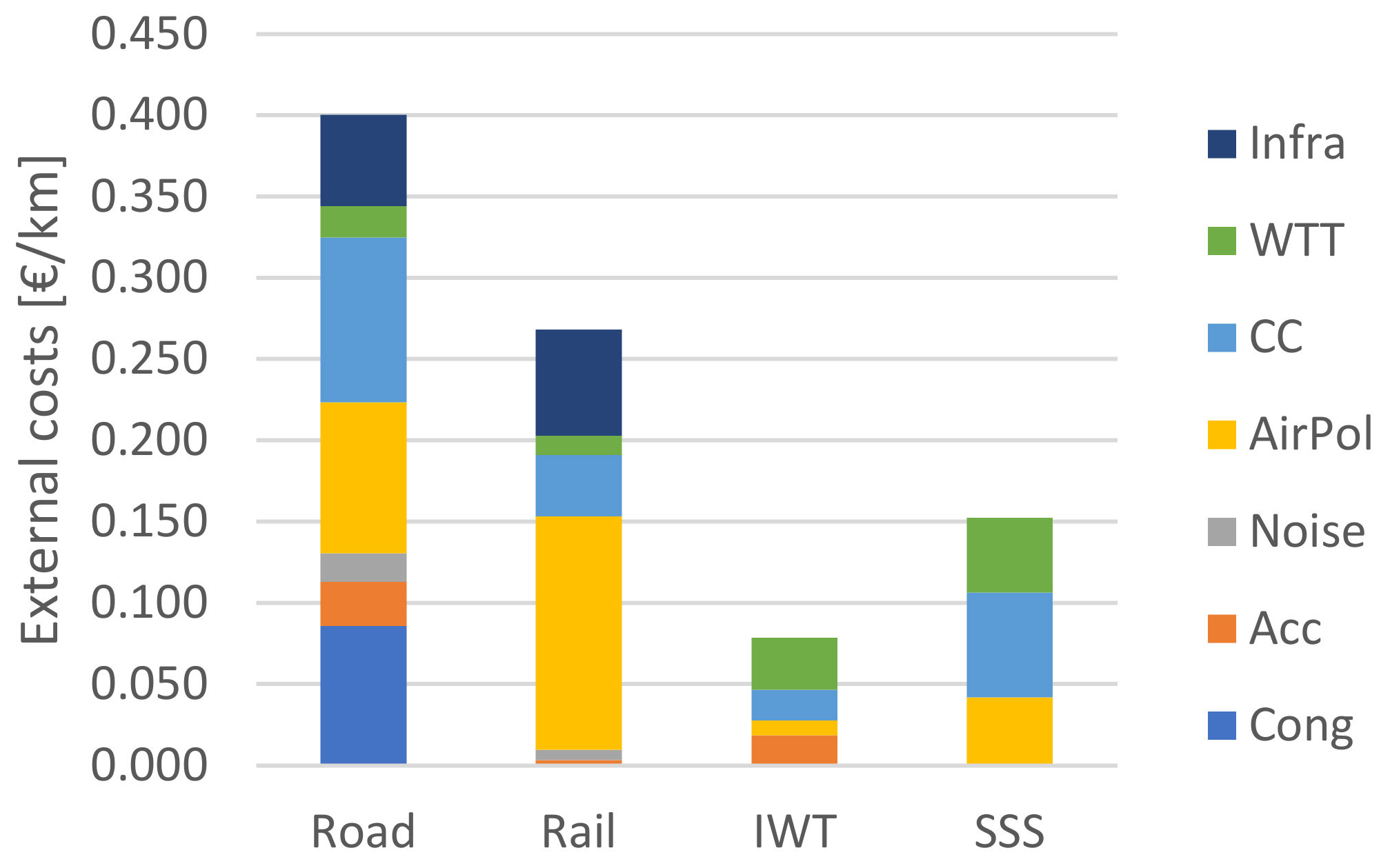


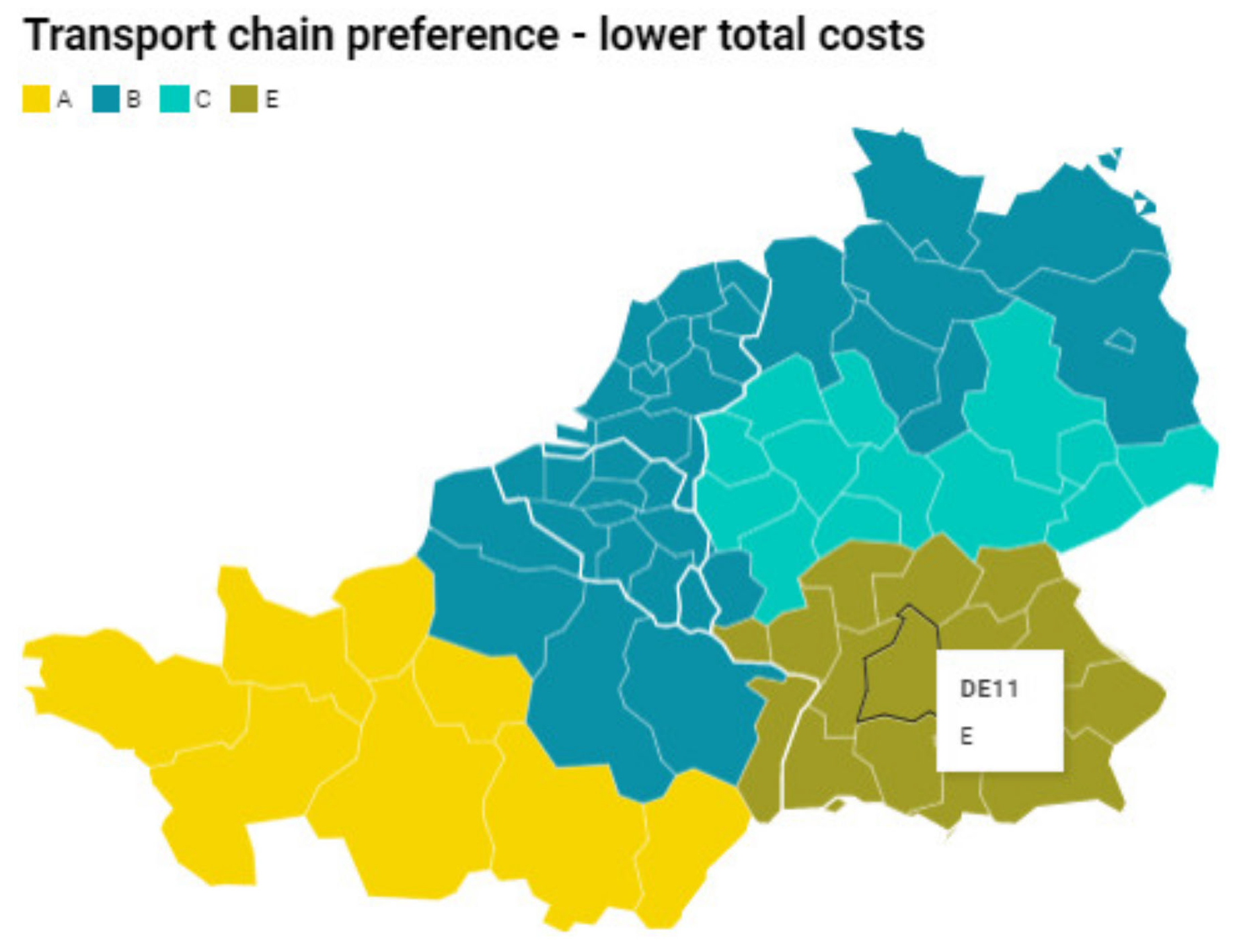
| Transport Mode | Accidents | Congestion | Noise | Air Pollution | Climate Change | Well-To-Tank Emissions | Infrastructure |
|---|---|---|---|---|---|---|---|
| Road transport | √ | √ | √ | √ | √ | √ | √ |
| Rail transport | √ | - | √ | √ | √ | √ | √ |
| IWT | √ | - | - | √ | √ | √ | - |
| Maritime transport | - | - | - | √ | √ | √ | - |
| Road Transport | Rail Transport | IWT | Maritime | |
|---|---|---|---|---|
| Accidents |
| Country |
| N/A |
| Congestion |
| N/A | N/A | N/A |
| Noise |
|
| N/A | N/A |
| Air pollution |
|
|
|
|
| Climate change | - | - | - | - |
| Well-To-Tank emissions |
| - | - | - |
| Infrastructure |
|
| N/A | N/A |
| Transport Chain | Name | Distances (% of Total Distance) | Distance Per Country | Zone Inland | Congested Roads | Average Speed |
|---|---|---|---|---|---|---|
| A | Road direct | Road distance: 2262.6 km (100%) | PT: 229.5 km ES: 532.6 km FR: 1180.9 km DE: 235.7 km | 95% Rural 4% Suburban 1% Urban | 10% level 3 2% level 4 1% level 5 | Road: 80 km/h |
| B | Intermodal–road and SSS | Road distance: 640.3 km (27%) Sea distance: 1720 km (73%) | PT: 9.2 km NL: 188.4 km DE: 442.7 km | 87% Rural 10% Suburban 3% Urban | 23% level 3 8% level 4 | Road: 80 km/h Sea: 15 kn |
| C | Intermodal–road, SSS and IWW | Road distance: 450.2 km (19%) Sea distance: 1720 km (72%) Inland distance: 234.6 km (10%) | PT: 9.2 km NL: 154.5 km DE: 521.1 km | 81% Rural 14% Suburban 5% Urban | 2% level 3 19% level 4 | Road: 80 km/h Sea: 15 kn Inland: 10 kn |
| D | Intermodal–road and rail | Road distance: 224.5 km (9%) Rail distance: 2216.8 km (91%) | PT: 437.5 km ES: 529.9 km FR: 1199.3 km DE: 274.6 km | 96% Rural 1% Suburban 3% Urban | 10% level 3 10% level 4 3% level 5 | Road: 80 km/h Rail: 37 km/h |
| E | Intermodal–road, SSS and rail | Road distance: 148.4 km (6%) Sea distance: 1720 km (71%) Rail distance: 548.18 km (23%) | PT: 9.2 km NL: 137.7 km DE: 480.3 km | 58% Rural 34% Suburban 8% Urban | 10% level 3 17% level 4 1% level 5 | Road: 80 km/h Sea: 15 kn Rail: 37 km/h |
Publisher’s Note: MDPI stays neutral with regard to jurisdictional claims in published maps and institutional affiliations. |
© 2021 by the authors. Licensee MDPI, Basel, Switzerland. This article is an open access article distributed under the terms and conditions of the Creative Commons Attribution (CC BY) license (https://creativecommons.org/licenses/by/4.0/).
Share and Cite
Ramalho, M.M.; Santos, T.A. The Impact of the Internalization of External Costs in the Competitiveness of Short Sea Shipping. J. Mar. Sci. Eng. 2021, 9, 959. https://doi.org/10.3390/jmse9090959
Ramalho MM, Santos TA. The Impact of the Internalization of External Costs in the Competitiveness of Short Sea Shipping. Journal of Marine Science and Engineering. 2021; 9(9):959. https://doi.org/10.3390/jmse9090959
Chicago/Turabian StyleRamalho, Mónica M., and Tiago A. Santos. 2021. "The Impact of the Internalization of External Costs in the Competitiveness of Short Sea Shipping" Journal of Marine Science and Engineering 9, no. 9: 959. https://doi.org/10.3390/jmse9090959
APA StyleRamalho, M. M., & Santos, T. A. (2021). The Impact of the Internalization of External Costs in the Competitiveness of Short Sea Shipping. Journal of Marine Science and Engineering, 9(9), 959. https://doi.org/10.3390/jmse9090959







